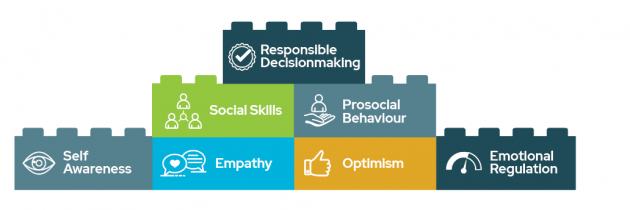Rethinking Pro-D to Support Learning & Well-Being
As we embark on a new school year, SCSBC is pleased to announce the launch of a new educator resource that is focused on building the well-being off both students and adults: the Well-Being BC website (launched early October 2019) www.wellbeingbc.ca
What is well-being and social-emotional learning? Well-being is defined as the experience of feeling happy and healthy, both mentally and physically. Well-being is strongly associated with having safe and caring relationships with others, a sense of purpose or meaning, and generally feeling satisfied with life. Social-emotional learning (SEL) is critical to “developing the skills and competencies related to recognizing and managing emotions, developing care and concern for others, establishing positive relationships, making responsible decisions, setting and achieving positive goals, and handling challenging situations constructively.” 1
What is the importance of fostering well-being? Research suggests that children who experience a greater sense of well-being are more able to learn and assimilate information in effective ways; more likely to engage in healthy and fulfilling social behaviours; more likely to invest in their own and others’ well-being and in the sustainability of the planet, as they take up their social, professional and leadership roles in adulthood. 2
There is a significant relationship between spiritual, mental and emotional well-being and mental health. We also know that effective prevention and early intervention can help to significantly reduce the prevalence of mental health issues. 3 When children learn about healthy attitudes, thinking and behaviours at a young age, they are better equipped to deal with challenges that they may experience later in life. At the same time, as a society, we need to ensure that people have access to resources and support at every stage of life, including during the school years.
What is Well-being BC?The purpose of the Well-being BC website is to provide a FREE professional development resource to build the capacity of educators within independent schools to support the social and emotional well-being of students and staff. This resource will also be shared publicly, to support the well-being of children and adults everywhere. The Well-being BC website contains a variety of resources, including:
1. Instructional Videos that introduce key concepts related to well-being and SEL, and feature interviews with local and international experts. 2. Video Viewing Guides that contain a summary of the video as well as reflection questions, are provided as an adult learning tool. 3. Infographics that provide a visual representation of the key messages from the videos.4. Assessment & Growth Plan Toolkit to promote Schoolwide Well-being and SEL.
For example, video interviews with internationally recognized experts such as Drs. Kimberly Schonert-Reichl, John Ratey, Stefanie Jones and Mark Greenberg, will connect SEL to topics that are important to educators in supporting well-being, including: physical health (e.g., sleep, healthy eating, exercise), service-learning, school climate, and strategies to support staff well-being. In addition, brief instructional videos show local educators demonstrating specific SEL practices, such as building a classroom charter, increasing student’s attention and focus through daily exercise, and measuring student’s emotional well-being using a Mood Meter.
Rethinking Professional Development: Ideas about how to use the Well-being BC Professional Development Resource:Well-Being BC is designed to be a flexible professional development tool that can be used in a variety of different ways. Users can decide on the order of topics, frequency of use, amount of time devoted to each topic and the number of educators in the group.
Be creative! Here are a few ideas to get you started:
Self-guided Individual Study:
Educators can use the resource independently to learn about SEL, reflect on their practices and implement the strategies demonstrated in the school-based videos. Many of the strategies illustrated in the videos can be implemented in 10 minutes during the school day.
Professional Learning Communities: Staff can get together in professional learning communities to focus on a common area of interest. Collaborative eLearning Group:
Conduct meetings through e-learning to collaborate with like-minded educators from other schools.
School Staff Meetings:
Administrators and learning leaders can choose a topic of interest to focus on for 15-20 minutes during staff meetings.
Special Acknowledgment: The wellbeingbc.ca website would not have been possible without the contributions of the experts and the school staff, parents, and students who are featured in the videos. By sharing their personal stories, passion and expertise, they helped create a resource that can be used to translate our vision of promoting childhood health and well-being with other educators throughout the province of BC and around the world.
Jenny Williams (jenny.williams@scsbc.ca)
SCSBC Director of Educational Support Services + Safe Schools
REFERENCES
1 Zins, J. E., Weissberg, R. P., Wang, M. C. & Walberg, H. J (Eds.). (2004). Building Academic Success on Social and Emotional Learning – What Does the Research Say. New York: Teachers College Press
2 Awartani, M. , Whitman, C. V. and Gordon, J. (2008). Developing Instruments to Capture Young People’s Perceptions of how School as a Learning Environment Affects their Well‐Being. European Journal of Education, 43: 51-70.
3 Center on the Developing Child (2013). Early Childhood Mental Health (InBrief). Retrieved from www.developingchild.harvard.edu.

